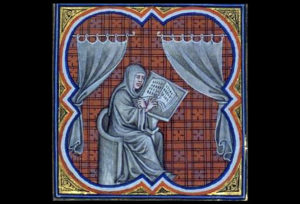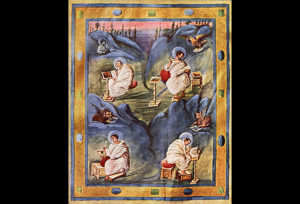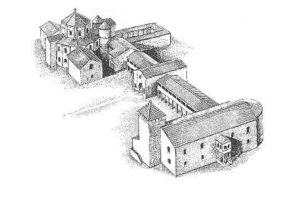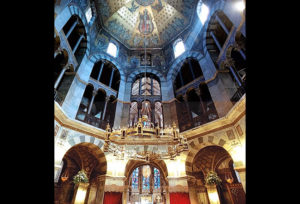The Carolingian Renaissance
 The Carolingian Renaissance is a period in the Middle Ages characterized by the revival of scholarship, and tagged with the figure of Charlemagne. After a period of stagnation and certain decadence in the development of intellectual awareness and art which marked the Middle Ages, in the second half of the 8th century there is a new uplift in these fields. Charlemagne brings the greatest scholars of his time to his court, in a desire to revive the level of artistic creation and nourishment of literacy from the time of the ancient Rome. Rome becomes an ideal in the recovery of art, architecture, philosophical writings. Transcriptions are made of ancient scholar works, which are some of the only copies of these works preserved to this day. As a result of a need for extended text on the scarce surface of pergaments, a new epistyle called minuscule is developed, which will have become the ground for today’s modern epistyle. Gina Pischel thus explains this Carolingian revival: „From an artistic point of view, the characteristic element of the Carolingian […] Renaissance, is the persistence to reinforce, through the restoration of the Empire, the culture that, sparse and defective, found its resort in desolate monasteries. To rediscover the greatness of Antique was a myth, and, at the same time, an aspiration for a new prestige; still it is a retrieval of immortal virtues and ideas that began to fade and obscure.“1
The Carolingian Renaissance is a period in the Middle Ages characterized by the revival of scholarship, and tagged with the figure of Charlemagne. After a period of stagnation and certain decadence in the development of intellectual awareness and art which marked the Middle Ages, in the second half of the 8th century there is a new uplift in these fields. Charlemagne brings the greatest scholars of his time to his court, in a desire to revive the level of artistic creation and nourishment of literacy from the time of the ancient Rome. Rome becomes an ideal in the recovery of art, architecture, philosophical writings. Transcriptions are made of ancient scholar works, which are some of the only copies of these works preserved to this day. As a result of a need for extended text on the scarce surface of pergaments, a new epistyle called minuscule is developed, which will have become the ground for today’s modern epistyle. Gina Pischel thus explains this Carolingian revival: „From an artistic point of view, the characteristic element of the Carolingian […] Renaissance, is the persistence to reinforce, through the restoration of the Empire, the culture that, sparse and defective, found its resort in desolate monasteries. To rediscover the greatness of Antique was a myth, and, at the same time, an aspiration for a new prestige; still it is a retrieval of immortal virtues and ideas that began to fade and obscure.“1
 The centers of this new scholarship were monasteries. They incorporated scriptoria where the transcriptions were made; the architecture was improved on their structures, and the interior was used for decorative art development. Still, secular clergy was kept outside of the monasteries, and they were educated in cathedral schools: „Even though cathedral schools became important institutions in ecclesiastical community, very little is known about them in the Carolingian period, and a certain thing is that clericals were generally corrupted, at least in Gaul. Bishops were often laymen and ignorant, they spent their lives on family feuds, in political intrigues, warfare, hunting and other favorite occupations of the half-barbaric nobility. The remarkable ones that could have become intellectual leaders, spent their energy christianizing pagan lands or reforming Christian hierarchy in those already Christianized. Therefore their enthusiasm for teaching and writing slowly faded away. This was the reason that both 7th and 8th century in Europe were quite destitute in literary creation and scholarship. There were only a few prominent writers.“2
The centers of this new scholarship were monasteries. They incorporated scriptoria where the transcriptions were made; the architecture was improved on their structures, and the interior was used for decorative art development. Still, secular clergy was kept outside of the monasteries, and they were educated in cathedral schools: „Even though cathedral schools became important institutions in ecclesiastical community, very little is known about them in the Carolingian period, and a certain thing is that clericals were generally corrupted, at least in Gaul. Bishops were often laymen and ignorant, they spent their lives on family feuds, in political intrigues, warfare, hunting and other favorite occupations of the half-barbaric nobility. The remarkable ones that could have become intellectual leaders, spent their energy christianizing pagan lands or reforming Christian hierarchy in those already Christianized. Therefore their enthusiasm for teaching and writing slowly faded away. This was the reason that both 7th and 8th century in Europe were quite destitute in literary creation and scholarship. There were only a few prominent writers.“2
Charles’ court
 In desire to revive scholarship and art, Charles starts gathering in his court the most eminent scholars of that time. Already in his father’s time there were teachers who educated young noblemen.3 He establishes a school in his court, and appoints Alcuin as the headmaster, who was until then the headmaster of the cathedral school in York, and considered the most erudite man of that time. Teachers come to the court in Aachen from all parts of the world: English, Irish, Italian, Spanish, Franks from Gaul and Germania.4 They visited abbeys and dioceses where they organized local schools, founded libraries, ordered transcriptions of old writings, standardized liturgy, and raised quality of church music.5
In desire to revive scholarship and art, Charles starts gathering in his court the most eminent scholars of that time. Already in his father’s time there were teachers who educated young noblemen.3 He establishes a school in his court, and appoints Alcuin as the headmaster, who was until then the headmaster of the cathedral school in York, and considered the most erudite man of that time. Teachers come to the court in Aachen from all parts of the world: English, Irish, Italian, Spanish, Franks from Gaul and Germania.4 They visited abbeys and dioceses where they organized local schools, founded libraries, ordered transcriptions of old writings, standardized liturgy, and raised quality of church music.5
Educational system
The educational system, previously reserved for narrow audience, now becomes slightly more attainable, but still without much influence on the education of entire society. The practices of Carolingian schools were organized according to the principle of seven Liberal arts. They are divided in two degrees: the Trivium (grammar, rhetoric and logic) and the Quadrivium (arithmetic, astronomy, geometry and music). The most important things students could’ve learned were reading and writing. Greek philosophy and science, apart from only a few works, were entirely unknown to them, so they less studied the practices of the Quadrivium. Mathematics and music were studied less as well. Such schools of the Latin West, by the quality and the scope of knowledge offered, were almost incomparable to the schools of the contemporary Muslim world.6
Art
 One of the most important news was the restoration of monumental architecture. The most important sacral buildings were built as basilicas, and not as central buildings (with the exception of the Palatine Chapel in Aachen). For example, the St. Denis’ Abbey in Paris, the Imperial Abbey in Lorsch and the monastic St. Emmeram’s Abbey in Regensburg are all shaped basilically.7 There are some novelties structurally as well, like the side entrances to the nave, apsidal endings on both eastern and western side of the church, westwerk and crypt. The new liturgical requirements are more and more considered in designing churches.8
One of the most important news was the restoration of monumental architecture. The most important sacral buildings were built as basilicas, and not as central buildings (with the exception of the Palatine Chapel in Aachen). For example, the St. Denis’ Abbey in Paris, the Imperial Abbey in Lorsch and the monastic St. Emmeram’s Abbey in Regensburg are all shaped basilically.7 There are some novelties structurally as well, like the side entrances to the nave, apsidal endings on both eastern and western side of the church, westwerk and crypt. The new liturgical requirements are more and more considered in designing churches.8
The most representative monumental building of the Carolingian renaissance is the Palatin Chapel in Aachen. It was built between the years 792 and 805, and was the spiritual center of Charlemagne’s court and the crowning hall of German rulers for the next 600 years. Today it is the core on which the Aachen cathedral was built, and looks very small compared to the later upgrades, but at the time it was built, it was the largest dome church north of the Alps.
The sculpture was still very modest, and continued the former tradition of simple decorations. Human figure is featured in miniatures made in ivory and gold (i.e. Vuolvinio, the golden altar of St. Ambrogio in the Basilica of St. Ambrogio in Milan).9
Only a little of wall painting was preserved, though it was developed remarkably in miniature painting, which was especially produced in imperial workshops and monasteries. It differs from the Anglo-Irish style in miniatures: „It reveals a strive for figuration and composition, in the effort of tendency for the classical, which readily switches from sacral themes to displaying the Emperor or his accomplishments.“10
The legacy of the Carolingian Renaissance
 What did this medieval revival of (primarily antique) scholarship really bring? Compared to the few centuries before, the period of Charlemagne’s reign can be truly considered a massive cultural ascent. The school system has been organized (though still available to a very limited number of students), literacy revived. Valuable works of antique science and literature have been transcribed in the Carolingian scriptoria, which would otherwise be irrecoverably lost.11 To these centuries we owe our present epistle system (minuscule).
What did this medieval revival of (primarily antique) scholarship really bring? Compared to the few centuries before, the period of Charlemagne’s reign can be truly considered a massive cultural ascent. The school system has been organized (though still available to a very limited number of students), literacy revived. Valuable works of antique science and literature have been transcribed in the Carolingian scriptoria, which would otherwise be irrecoverably lost.11 To these centuries we owe our present epistle system (minuscule).
Still, there was no literacy and literature in native language. The only expression of folk art were heroic chants sang by travelling musicians. Although Einhard states that Charles ordered the transcription of these chants, not a single one was preserved to this day.12
Historians are still ambivalent about the proper characterization of the period of Charlemagne’s rulership. Does it reflect the last glare of Antique, or show the first peak of medieval Europe?13 It is fair to say that this was an issue for Charles’ coevals. They imitated Antique, especially in architecture, but they also realized it was not really Antique any more.
Charlemagne’s rulership was de facto the first cultural rise since the golden age of Ancient Rome. By perceiving his rulership and the organization of the Frankish Empire, and even the act of his crowning itself,14 this is definitely a culture in domain of the Middle Ages. The fact that they found their ideals in Antique, does not indicate a desire to resurrect the antique society. Through history, the Antique, especially antique Rome, were periodically used as an inspiration, and the reconstructions of Antique occurred more than once. Therefore, in this case we can actually say this is the first renovatio, a strive to reach the former peak of education, culture and art, and that speaks of high level of self-conscience in the time of Charlemagne.
Other articles from the “Charlemagne” series
- Charlemagne: Private Life – The First Part
- Charlemagne: Political life and warfare – The Second Part
- Charlemagne: Carolingian Renaissance – third part
- Charlemagne: The Carolingian Influence in Croatian Lands– The Fourth Part
- In architecture of the Carolingian Renaissance the ideal was the architecture of the Ancient Rome (i.e. the Palatin Chapel in Aachen was modeled on the church of St. Vitale in Ravenna)
- Some works of antique literature were preserved exclusively from the transcripts made in Carolingian scriptoria
- In Carolingian schools practices were organized according to the principle of seven Free Arts, which were divided in two degrees: the Trivium (grammar, rhetoric and logic) and the Quadrivium (arithmetic, astronomy, geometry and music)
- In this period a new epistle was developed, called the miniscule, which will have become the ground for today’s epistle
- KENNETH JOHN CONANT, Carolingian and Romanesque Architecture 800 to 1200, Yale University Press, 1993.
- EINHARD, Život Karla Velikog, Biblioteka Latina et Graeca, Zagreb, 1992.
- SLAVKO GOLDSTEIN (ur.), Atlas svjetske povijesti, Grafički zavod Hrvatske, Zagreb, 1987.
- HORST WOLDEMAR JANSON, ANTHONY F. JANSON, Povijest umjetnosti, Stanek d.o.o., Varaždin, 2003.
- GINA PISCHEL, Opća povijest umjetnosti 2, Mladost, Zagreb, 1970.
- MELITA TOMAŠEVIĆ (ur.), Povijest svijeta, Marjan tisak, Split, 2005.
- 1 “S umjetničkog gledišta, karakteristični element karolinške […] renesanse, jest nastojanje da se obnavljanjem Carstva učvrsti i ona kultura koja je, prorijeđena i manjkava, bila našla utočište u osamljenim samostanima. Ponovno pronaći veličinu antike bio je mit, i ujedno, želja da se postigne novi ugled; ali to je ipak ponovno pronalaženje vječnih vrednota umjetnosti i misli koje su se bile počele gubiti i zamračivati.” GINA PISCHEL, Opća povijest umjetnosti 2, 9
- 2 “Iako su katedralne škole postale važne ustanove u crkvenoj organizaciji, o njima se u pretkarolinško doba malo zna, a sigurno jest da je svećenstvo, barem u Galiji, općenito bilo iskvareno. Često su biskupi bili svjetovnjaci i neznalice, provodili su život na obiteljskim feudima, u političkim intrigama, ratovanju, lovu i drugim omiljenim zanimanjima polubarbarskog plemstva. Oni izuzetni svećenici koji su mogli postati i intelektualne vođe, trošili su energiju pokrštavajući poganske zemlje ili reformirajući kršćansku hijerarhiju u već pokrštenima. Tako je i njihov polet za poučavanjem i pisanjem nestajao. Zbog toga su i 7. i 8. stoljeće u Europi bili po literarnoj produkciji i učenosti vrlo siromašni. Značajnijih je pisaca bila nekolicina.“ EINHARD, Život Karla Velikog, 22
- 3 EINHARD, 22
- 4 EINHARD, 22
- 5 EINHARD, 22
- 6 EINHARD, 25
- 7 GINA PISCHEL, 11
- 8 JANSON, 275
- 9 GINA PISCHEL, 11
- 10 GINA PISCHEL, 12
- 11 EINHARD, 25
- 12 EINHARD, 26
- 13 EINHARD, 26
- 14 Crowned by Christian leader – the pope, what would become a practice that will continue even after the Middle Ages
AWESOMENESS!
Thanks for all incredible bank of information!
nice job
really good info!
Awesomesauce!!! Really helpful,found everything I needed 🙂
Hi, enjoyed your site – because I am also fascinated by medieval culture (also in literature = Parzival!).
Thanks!
Thanks so much, this just helped me beyond measure with my Church History presentation TOMORROW! 😀
This is such a reliable source of information and is very consistent. Thank you!! 🙂
WOW, you are amazing! Great writer; very clear information. Thank you very much!
Thank You for such a good information. But it is too short.
Awesome stuff here, helped me out a lot in a very important assignment I had to do.
Thankyou very much!
Great stuff
Thanks so much, as I am a direct descendent of this interesting man. What a different time back then!
the information is so enriching…i really love it..its so sweet
Hey, awesome article with (what looks to be) great information. We were just wondering if you could include the sources? 🙂 We’re making a documentary for our Social Studies class about the Carolingian Renaissance and we are required to put our sources for the information we will include in the docu. Thank you!
Really helpful! Needed to find information on Charlemagne’s achievements, and this is perfect!
Can you include the sources? This doesn’t correspond with something I saw, but I trust this more.
Is the any sources that you used? I need to Cite them in a history paper. thank you
Hi @Ethan, you can check the sources by clicking in right sidebar on the link “Literature”. If you are looking for specific notes, you can also click on number of the note within the post or the “Notes” link in right sidebar at the top of the post. Hope this helps…
Nice informations. Seems authentic.